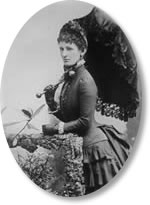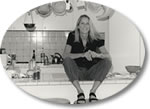Main site navigation
Giving and voluntarism have traditionally provided - and continue to provide - the means through which women have grasped, wielded, and maintained public power… As such, philanthropy lies at the heart of women's history.
Kathleen McCarthy, Lady Bountiful Revisited, 1990.

Janet Clarke

Jill Reichstein
In Her Gift: Women Philanthropists in Australian History
In December of 1885, Melbourne's Table Talk magazine profiled society hostess Janet Lady Clarke, bestowing upon her the title of Australian Lady Bountiful: 'Away in the back slums of this great city', it wrote, 'through foetid alleys and festering lanes, the noble sisterhood of the Melbourne District Nursing Society pursue their errands of mercy, and among that band of ministering angels Lady Clarke is one of the most devoted. What spectacles of squalid misery, what shapes of horrid disease, what fathomless abysses of degradation these delicately nurtured ladies have to encounter in their self-imposed mission cannot be described in these pages'. Like her husband, Lady Clarke was upheld as the ultimate example of beneficence in a human being, though Table Talk was careful to remind its readers that 'in subscribing generously out of their ample means to the public charities... Sir William and Lady Clarke are merely discharging a duty appertaining to their exalted position'. This was noblesse oblige, pure and simple.
Australian women's philanthropy has its roots in charitable work. Nineteenth-century women who, like Lady Clarke, were able to supplement their voluntary work with large financial contributions were few and far between, and were inevitably the wives and daughters of wealthy men. Australia did not have the aristocratic wealth of the United Kingdom, where Baroness Angela Burdett-Coutts gave away close on £3 million before the turn of the century. Nor did it have the vast wealth of the industrialising United States, allowing twelve women philanthropists in Chicago alone to give nearly $800,000 to charitable causes in the 1880s. Back in the colony, Elizabeth Austin was making headlines with a £6,000 donation to build the Austin Hospital. Despite the comparative lack of money, engagement in some form of philanthropic service was expected of privileged women who were motivated variously by religious faith, a desire for social status, the fulfilment of social obligation, and simple altruism, profound and true. There was, by the 1890s depression, an explosion of charitable organisations run by women - albeit with finance usually controlled by men. By 1933, a correspondent for the Women's Weekly was bemoaning the excessive number of fundraising events, from fetes to motor picnics, card parties to dances where 'the smell of moth balls and petrol exuded from resurrected furs and newly cleaned gloves'. Still, this kind of activity was restricted on the whole to women who were members of a social and economic elite, and who erred on the side of political conservatism.
Within this rather restrictive climate, a number of Australian women philanthropists did break the mould. Anne Bon, a widow and property-owner in north-east Victoria from the 1860s, offered funding along with her substantial energy to assist in the plight of the Aboriginal people near her home - dispossessed members of the Taungurung tribe - and to open a school for Chinese children in Melbourne. In Sydney in 1922, Dr Lucy Gullett co-founded what would become the Rachel Forster Hospital, offering training for female medical students and catering to the needs of 'home-tied' mothers. Publican Mary Raine, who arrived in Australia with £100 in savings in 1900, single-handedly built up a hotel empire and gave nearly £1 million to the University of Western Australia for medical research. Lady Mary Windeyer leant considerable political weight to the cause of the Womanhood Suffrage League, and financially supported the women's college at Sydney University. Dr Una Porter persisted in her medical studies in the 1930s despite blatant discrimination from male lecturers and spent decades working as a psychiatrist at Melbourne's Queen Victoria Hospital for women. She gave over $1 million to various hospitals and institutions, funding, among other projects, a scholarship for rural female students to attend university, a Chair in Psychiatry, and extensive research into early childhood development.
Throughout the twentieth century, possibilities for women's active involvement in philanthropy expanded for a number of reasons: the award of political citizenship for women; rapid economic growth after World War Two; shifts in population size and composition with a surge in the migrant population; the development of the formal philanthropic foundation; and the social upheaval of the 1960s and 70s, particularly the expansion of education and the rise of second wave feminism. With access to employment and the freedom to earn their own money, the social and financial position of women was being completely reshaped. From the 1970s onward, a number of philanthropic foundations took the lead in pushing for social change, and many of them were driven by women. Jill Reichstein overturned the all-male board of the Lance Reichstein Foundation and her work encouraged other women to come forward. At the Myer Foundation, Meriel Wilmot launched the Aborigines in Australian Society project, investigating the effects of government policy upon the Indigenous population. Pat Feilman led the Potter Foundation's Farmland Project, introducing sustainable farming practices to rural Australia. At the helm of her parents' philanthropic foundation, established with a sunset clause, Sarah Stegley joined forces with Jill Reichstein in the push for social change and funded disadvantaged youth, the aged, the disabled, and Aboriginal communities. In 1985 the Victorian Women's Trust was established with the collaboration of women politicians, philanthropists and community workers: a trust run by women, for women. Today, Australian women sustain an outstanding presence at the highest levels of decision-making in the 'third sector' of the economy. The Women Donors Network has taken up the mantle of the former Women In Philanthropy group, and women are collaborating more effectively than ever. If one trend joins the philanthropy of nineteenth-century women to that of the twentieth and the twenty-first, irrespective of class, creed, or political orientation, it is the tendency for women to work in groups. They may be charitable organisations, they may have an agenda for political or social change, they may have formed around a common interest: the activism within women's philanthropy, where it exists, derives its strength from groups.
Of course, the philanthropy of many Australian women is still traditional in style - reliant upon old names and networks, long-established institutions, and well-worn cheque books - and this is just as well. Without it our galleries, hospitals, theatres and universities would founder. The important change overriding this continuity lies in the relationship between women and money. It is in the expansion of tradition; in the machinations of philanthropy; in the far greater number of independently wealthy women in Australia; and in the sense of ownership they attach to their wealth. Women may have less time for voluntary work today, but they are inclined to give generous financial support instead. Australia's most likely donor is female and middle-aged from the higher income and higher education brackets. Women donate in smaller amounts than do men, on average, but they donate more often.
The future looks bright for Australian women philanthropists. In late 2007, Trisha Broadbridge was interviewed for ABC radio. As a philanthropy manager with ANZ Trustees and founder of the Reach Broadbridge Fund, she noted the hesitance of some women to become involved in philanthropic funding, but remarked: 'I actually think that it's time for women to step into this arena and to step into many arenas and not be scared to make social change, and I think it's women that are going to do it... I think that women can be very powerful', she said, 'because women are always in groups... In groups women can make these changes.' Going by the work of the Victorian Women's Trust, the Sydney Women's Fund, the Angel Investment Network and the Women Donors Network among others, there can be little doubt that she is right.
[Reproduced from Australian Philanthropy, Issue 71, Summer 2008, with the kind permission of Philanthropy Australia]